|
Contents Of This Report: |
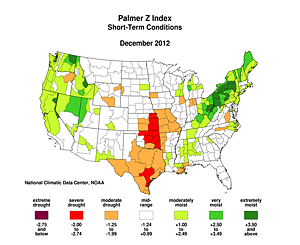
|
Please note that the values presented in this report are based on preliminary data. They will change when the final data are processed, but will not be replaced on these pages.
National Drought Overview
|
|
[top]
Detailed Drought Discussion
Overview
Temperatures were unusually warm during the first week of December, but a circulation change at mid-month brought colder-than-normal air masses to the central regions during the last week (weeks 1, 2, 3, 4). Pacific cold fronts and low pressure systems dumped above-normal precipitation on parts of the country (weeks 1, 2, 3, 4), but they mostly missed the central drought areas. The beneficial rain and snow helped improve drought conditions over parts of the West, especially the Sierra Nevada and Intermountain Basin, and precipitation from the frequent frontal systems and low pressure centers chipped away at the drought areas in the Southeast before the systems moved northeast. But drought intensified in the Plains and expanded in Hawaii. When the temperature and precipitation are averaged across the country for the entire month, December 2012 ranked as the tenth warmest and 20th wettest December in the 118-year record. While not enough to significantly reduce the national drought footprint, the December precipitation did arrest further deterioration on a national scale — the national moderate to exceptional drought footprint decreased from 62.7 percent at the end of November to 61.1 percent at the end of December. According to the Palmer Drought Index, which goes back to the beginning of the 20th century, 51.8 percent of the contiguous U.S. was in moderate to extreme drought at the end of December, a decrease of about 8 percent compared to last month.
By the end of the month, the core drought areas in the U.S. included:
- a large area of moderate (D1) to exceptional (D4) drought stretching from the West, across the Northern to Southern Plains, into the Upper Midwest and Mid-Mississippi Valley, with the most intense drought centered in the Plains states;
- a persistent area of moderate to exceptional drought in the Southeast to Mid-Atlantic; and
- much of Hawaii, where moderate to extreme (D3) drought persisted.
Palmer Drought Index
The Palmer drought indices measure the balance between moisture demand (evapotranspiration driven by temperature) and moisture supply (precipitation). The Palmer Z Index depicts moisture conditions for the current month, while the Palmer Hydrological Drought Index (PHDI) and Palmer Drought Severity Index (PDSI) depict the current month's cumulative moisture conditions integrated over the last several months.
 |
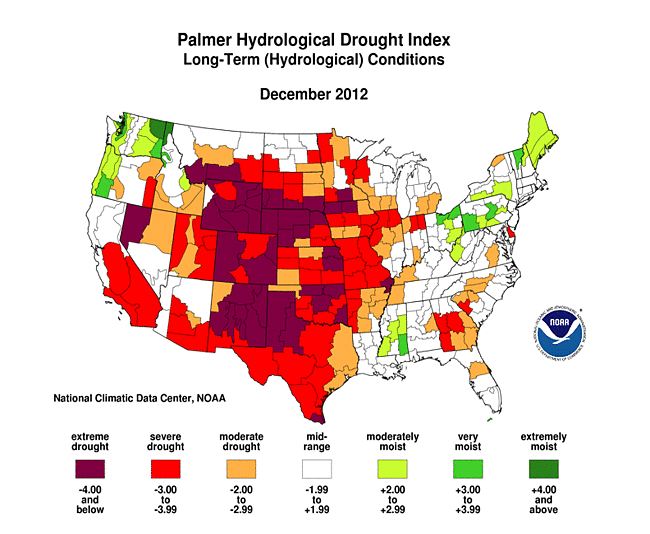 |
Used together, the Palmer Z Index and PHDI maps show that the December short-term moisture conditions improved long-term drought in the West, Northern Plains, Upper Midwest, and Southeast, but December short-term conditions deteriorated long-term drought in the Central and Southern Plains (December PHDI compared to November PHDI). The combination resulted in a decrease in the total percent area under drought. The Northeast and Northwest also received above-normal precipitation in December, but they were already mostly drought-free.
Standardized Precipitation Index
The Standardized Precipitation Index (SPI) measures moisture supply. The SPI maps here show the spatial extent of anomalously wet and dry areas at time scales ranging from 1 month to 24 months.
 |
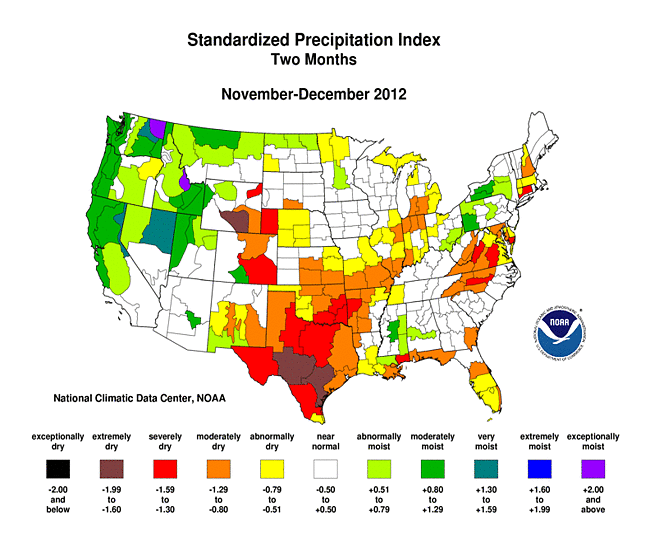 |
 |
The 1-month SPI map shows that the moisture deficiencies in December were moderately dry or worse for only parts of the Central and Southern Plains and Central Rockies. December was moderately to extremely moist for parts of the West and Upper Midwest, a little of the Deep South, and much of the Ohio Valley to Northeast. Much of the West (especially the northern sections) and Northern Plains was wet at 2 and 3 months, parts of the West were wet at 6 and 9 months, and the Northwest was wet at all time scales from 2 to 24 months. Dryness appears in pockets of the Northeast at 2 to 12 months, but the general pattern is wet conditions at most time scales. Dryness in the Mid-Atlantic is obvious at 2 to 12 months, while recent rainfall has helped the Southeast at 1 to 2 months but dryness becomes more pervasive at the longer time scales starting at 3 and going to 24 months. The Central Rockies were dry from 2 to 24 months, with the most extreme dryness at 9 and 12 months. The Southwest was also dry from 2 to 24 months, but the most extreme dryness is evident at the longer time scales. The 2012 drought of the Great Plains and Midwest shows up at time scales as short as 2 months, but is most evident at 6 to 12 months.
 |
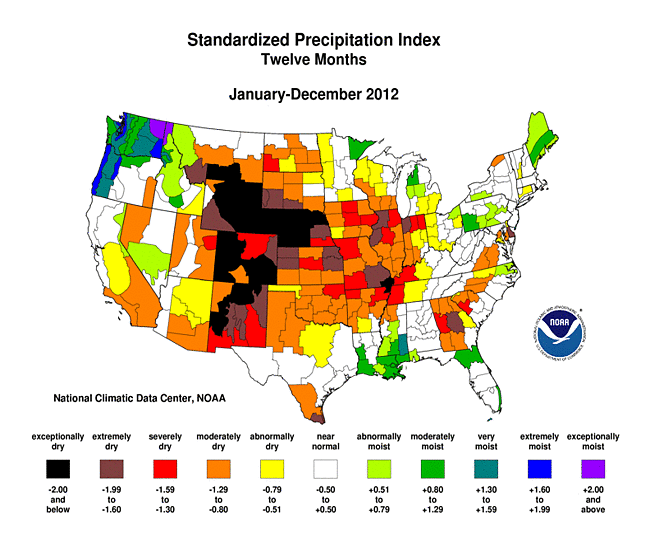 |
 |
Agricultural and Hydrological Indices and Impacts
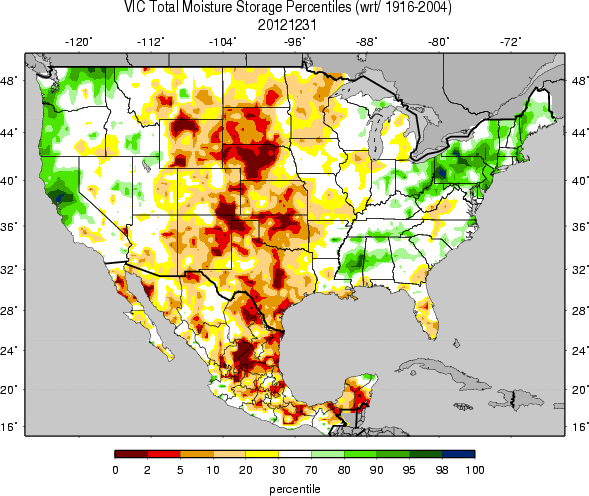 |
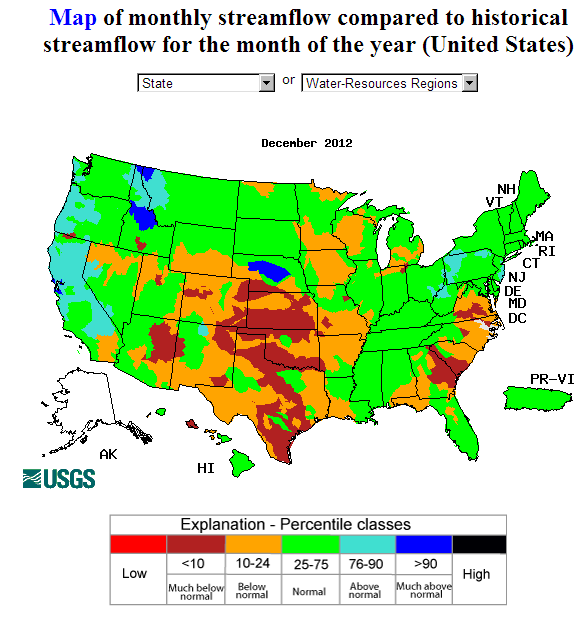 |
Drought conditions were reflected in numerous agricultural, hydrological, and other meteorological indicators, both observed and modeled.
Agricultural:
According to the U.S. Department of Agriculture (USDA), as of January 1, 62 percent of winter wheat, 64 percent of hay, and 73 percent of cattle were in drought. For the 26th consecutive week (July 10, 2012 - January 1, 2013), drought encompassed more than two-thirds of the domestic cattle inventory and at least 60 percent of the domestic hay acreage.
- NOAA Climate Prediction Center (CPC) modeled soil moisture anomalies and percentiles for the end of the month;
- CPC's Leaky Bucket model soil moisture percentiles;
- NLDAS (North American Land Data Assimilation System) modeled soil moisture percentiles for the top soil layer and total soil layer;
- VIC (University of Washington Variable Infiltration Capacity macroscale hydrologic model) modeled soil moisture percentiles;
- Vegetation Drought Response Index (VegDRI);
- the NOAA/NESDIS satellite-based Vegetation Health Index (VHI);
Hydrological:
- USGS observed streamflow percentiles;
- VIC 1-, 2-, 3-, and 6-month runoff percentiles;
- NLDAS model runoff anomalies and percentiles;
- NLDAS modeled streamflow anomalies and percentiles;
- USGS groundwater observations (real-time network, climate response network, total active network);
- USDA snow water content observations for the West (SNOTEL station percentiles, SNOTEL station percent of normal, SNOTEL basin percent of normal and percent of average) and Alaska (SNOTEL station percent of normal, SNOTEL basin percent of normal);
- VIC modeled snow water content percentile;
- National Weather Service (NWS) National Operational Hydrologic Remote Sensing Center (NOHRSC) national snow analysis snow depth and snow depth anomalies;
- NOAA/Rutgers University Global Snow Lab satellite-observed snow cover anomalies;
- USDA statewide reservoir storage as percent of capacity;
Meteorological:
- total precipitation (plotted by the USGS, NOAA National Weather Service [NWS], and NOAA High Plains Regional Climate Center [HPRCC]);
- percent of normal precipitation and precipitation percentiles (NWS, CPC, HPRCC station observations, Leaky Bucket model), precipitation anomalies (CPC);
- NCDC statewide precipitation ranks;
- USGS number of days with precipitation and maximum number of consecutive dry days;
- temperature departures from normal (CPC, HPRCC) and temperature percentiles (CPC, Leaky Bucket);
- NCDC standardized temperature departures and statewide temperature ranks; and
- number of record warm daily low temperatures, record daily high temperatures, record daily low temperatures, and record cool daily high temperatures, set during the month (from NCDC's daily records analysis).
Regional Discussion
Hawaii: December 2012 was another very dry month for the Hawaiian Islands, especially for the leeward stations. Honolulu was record dry for December with only 0.01 inch of rainfall. The pattern of below-normal rainfall was evident at most time periods (especially the last 2, 3, 6, and 36 months, but also the last 9, 12, and 24 months), and streamflow was below normal, especially on Oahu. Moderate to extreme drought affected almost two-thirds of the state, about ten percent more than last month.
Alaska: Most of the stations in Alaska were drier and cooler than normal during December 2012, giving the state its 31st driest and 18th coolest December in the 1918-2012 record. The dryness is widespread at 2, 3, and 6 months, especially from the central to southeastern stations. But the pattern is mixed at longer time scales (9, 12, 24, and 36 months). An area of abnormal dryness covers the northern and eastern two-thirds of the state on the USDM map, and a spot of moderate drought was added to the Koyukuk Basin where the water content of the snowpack was extremely low (21 percent of average).
Puerto Rico: Eastern Puerto Rico was drier than normal during December. The last 2 to 3 months have been very dry in the southeastern areas, with this dryness evident at longer time scales (6 to 12 months). An area of D0 (abnormally dry) was added to the USDM map where December streamflows were consistently low.
 |

|
On a statewide basis, December 2012 ranked in the driest third of the historical record for three states — Texas, Oklahoma, and Missouri. The area of dryness was still centered in the Southern Plains at three months, with Texas (third driest) and Oklahoma (ninth driest) having the tenth driest, or drier, October-December and eleven other states ranking in the direst third of the historical record.
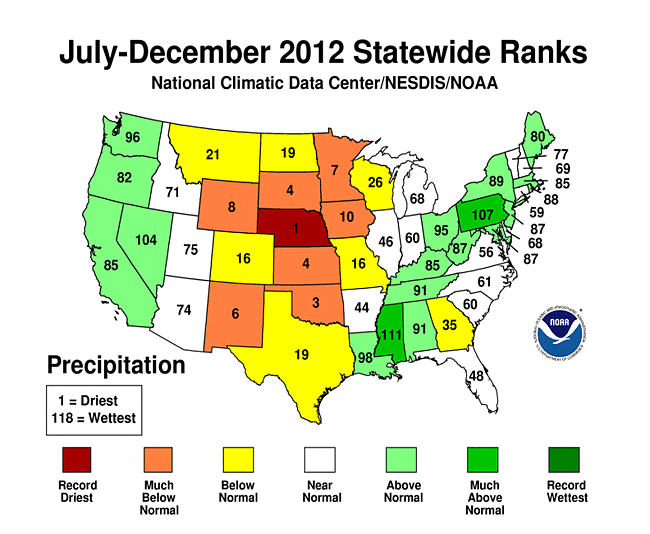
|

|
At the six-month time scale the Rockies to Great Plains and Upper Midwest were the epicenter of dryness, with Nebraska having the driest July-December in the 1895-2012 record and seven other states ranking in the top ten driest category. It was so dry in Nebraska that the state was driest for all seasons from August-December back to January-December.
 |
 |
The spatial pattern of dryness for the year was similar to that for the last 6 months, except the dryness stretched further into the Ohio Valley and from the Southeast to the Mid-Atlantic states. Nebraska and Wyoming had the driest year on record and eight other states ranked in the top ten driest category, including Georgia and Delaware. It was so dry in Wyoming that the state was driest for all seasons from April-December back to January-December.
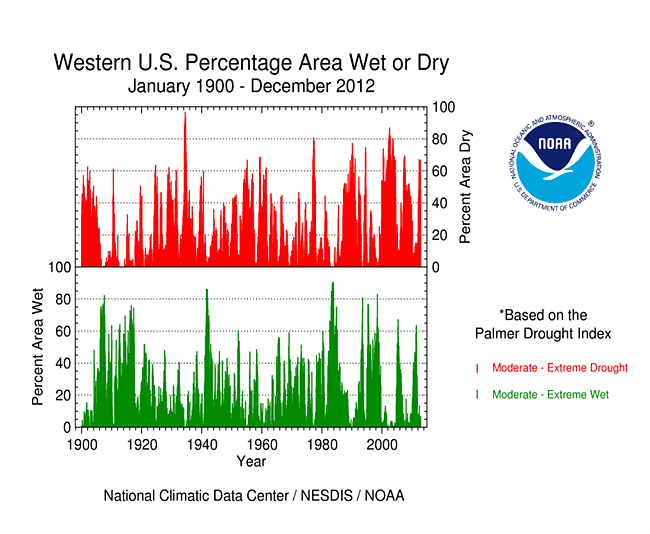
Percent area of the Western U.S. in moderate to extreme drought, January 1900 to present, based on the Palmer Drought Index.
Beneficial rain and snow fell across much of the West during December. Above-normal temperatures were not as widespread this month, allowing the buildup of a substantial snow pack in places. Water year-to-date (October-present) precipitation was above-normal in the northwestern regions and below-normal in the southeastern areas of the West — especially in the Central and Southern Rockies — as seen in both low elevation and high elevation (SNOTEL) stations. Snow pack snow water content (station percentiles, basin percent of normal) was below-normal in the Central to Southern Rockies, where precipitation was lacking, and also below-normal across parts of the Great Basin to Pacific Northwest, where temperatures have been above normal. Reservoir storage was above average, statewide, in Montana and Washington, where abundant precipitation has fallen so far this water year, near average in Wyoming and Utah, which have received beneficial precipitation recently, but below average in the southwestern states as well as Idaho and Oregon in the northwest. According to the USDM, 69.3 percent of the West was experiencing moderate to exceptional drought at the end of December, a three percent decrease compared to November. The Palmer Drought Index percent area statistic was about 48 percent, a decrease of 18 percent compared to last month.
NOAA Regional Climate Centers:
A more detailed drought discussion, provided by the NOAA Regional Climate Centers and others, can be found below.
West — Upper Colorado River Basin — Pacific Islands
As described by the High Plains Regional Climate Center, several storm systems passed through the High Plains region this month bringing much needed precipitation. Although there were many areas which received above normal precipitation, there were also large areas of the region which did not receive much precipitation this month, including a large area of southeastern Kansas, eastern North Dakota, and eastern Wyoming. These areas received less than 50 percent of normal precipitation. Meanwhile, much of southeastern Kansas received less than 25 percent of normal precipitation. For the areas that received rain and snow this month, the precipitation was only enough to stave off further deterioration of the drought. Overall, about 93 percent of the region was still in moderate (D1) to exceptional (D4) drought. This was down slightly from the end of last month when 94 percent of the region was in D1-D4. There were slight improvements in west-central North Dakota where a small section of abnormally dry conditions (D0) were erased and in southwestern Wyoming where a small section of extreme drought (D3) was downgraded to severe drought (D2). Drought conditions worsened slightly in Colorado and other areas of Wyoming. In Wyoming, D3 filled in the central part of the state and a small section of D4 developed in the southwest. In Colorado, D2 expanded in the north, and D3 and D4 conditions expanded slightly in the south.
As explained by the Southern Regional Climate Center, December was a much warmer month than normal over the entire region, drier than normal for the western half of the region, and wetter than normal in the eastern half. Because much of the drought in the Southern region is confined to Texas, Arkansas and Oklahoma, where precipitation was below average for the month, drought conditions remained relatively unchanged. There is a slightly larger area of extreme and severe drought in central Texas. In addition, the heavy rains in Louisiana helped remove drought conditions in the west central parishes. Some improvement also occurred in western Tennessee. With state-wide reservoir storage in a declining trend, new water usage restrictions are in place in Austin, Corpus Christi, and several places in north central Texas. Other places are developing new plans for water conservation and storage. The North Texas and Upper Trinity water districts have seen significant declines in reservoir storage in recent months, with the latter planning on adding new lakes to its draw pool to increase total supply storage. Older plans are being further developed, such as the San Angelo plan to develop piping to the Hickory Aquifer, which is expected to see completion by September, 2014. Above average temperatures and low short-term rainfall are also driving concerns over potential wildfires, as evidenced by Bastrop's requesting an additional $7 million for fire response and grassland fires causing strain on some fire response teams (Information provided by the Texas Office of State Climatology). Dryland crops in central Texas continue to struggle with concerns that winter wheat will not have significant yields. Farmers in the Panhandle are feeling the same concerns, though slightly higher precipitation accumulations are buoying their crops for the time being. Farmers all over the state are concerned about their fiscal future, as the 2008 farm bill allocating $300 billion in farm subsidies expired this year and progress on a new bill has been slow; suggested cuts to the bill between 20 to 30 billion dollars over 10 years is another cause for concern (Information provided by the Texas Office of State Climatology).
As summarized by the Midwest Regional Climate Center, December temperatures ranged from near normal in northwest Minnesota to as much as 7 degrees F (4 C) above normal in Illinois and Indiana. The first two-thirds of the month were well above normal with the warmest days on the 3rd and 4th recording hundreds of record high temperatures across the Midwest. Cooler temperatures in the final week of the month were not enough to drag the monthly values back down to normal. Despite the warm temperatures, December had multiple significant snows affect parts of the region. December precipitation totals ranged from less than half normal in northwest Minnesota and western Missouri to more than twice normal in southwest Minnesota and southeast Ohio.
In the Midwest, 2012 ranked as the 12th driest calendar year since 1895. Missouri (7th), Illinois (10th), Indiana (11th), and Iowa (11th) all ranked among the driest 10 percent of years and Kentucky and Michigan ranked among the driest 25 percent of years. Drought conditions were widespread in 2012. Drought expanded from 20 percent or less of the region than in the first five months of 2012 to more than 70 percent in July before dropping to around 55 percent by the end of the year. Areas in extreme drought topped 10 percent in July and climbed to more than a third of the region in August before dropping back below 10 percent in November. Drought conditions were most severe in the western third of the Midwest at the end of the year.
As noted by the Southeast Regional Climate Center, monthly average temperatures for December were above normal across the Southeast region, including Puerto Rico and the U.S. Virgin Islands. Precipitation was variable across the region. The driest locations were found across South Florida, where monthly rainfall totals were less than 1 inch (25.4 mm), or about 25 percent of normal. Precipitation in December was also variable across Puerto Rico, with above normal rainfall across the southern and western slopes and below normal rainfall across much of the interior and eastern portions of the island. Monthly precipitation was generally below normal across the U.S. Virgin Islands.
Drought conditions continued to persist across the Southeast in December, as roughly 50 percent of the region was experiencing at least moderate drought (D1 and greater), according to the USDM by the end of the month. Areas of severe drought (D2) expanded across northern sections of South Carolina and parts of southwestern North Carolina, while the lack of rainfall across south Florida contributed to the re-emergence of abnormally dry (D0) conditions by the end of December. The dry weather across South Florida forced some citrus farmers to begin irrigating their groves, while warm temperatures aided in the growth of winter vegetables and the harvesting of some early winter crops. Farmers were also beginning to assess whether the subfreezing temperatures experienced towards the end of the month damaged any of their crops. In Georgia, all boat ramps on Lake Lanier were closed indefinitely on the 13th of the month due to low lake levels. However, beneficial rains across North Georgia helped raise the lake level nearly 18 inches (0.5 m) over the last two weeks of the month.
As explained by the Northeast Regional Climate Center, after a cooler than normal November, December returned to the 2012 trend of above normal temperatures. On the heels of one of the driest months on record, December turned out to be wetter than normal. With 5.27 inches (133.86 mm) of precipitation (151 percent of normal), it was the 9th wettest December in 118 years in the Northeast. All states reported wetter than normal conditions. Despite a wet end to the year, the Northeast's annual precipitation total of 42.78 inches (1086.61 mm) was only 96 percent of normal. Delaware, even after being poured on by Hurricane Sandy in October, was the driest of the states. The state was down 11.33 inches (287.78 mm) of precipitation, making it the 6th driest year since 1895.
As summarized by the Western Regional Climate Center, much of the West saw a continuation of the above normal temperatures that have dominated this calendar year. Positive anomalies were seen throughout the month until the final week, when clear skies, persistent snow cover, and inversions produced cold temperatures that moderated the monthly average to near-normal values at many valley and basin locations. Precipitation was abundant throughout much of the West as an active pattern in the North Pacific brought a series of storms and moderate to heavy precipitation. In contrast, central Alaska continued to follow a trend of cooler than normal temperatures that have persisted through the fall. As Arctic sea ice extent increases after September's all time low, the positive temperature anomalies present along Alaska's North Slope throughout summer and fall finally gave way to cooler than normal December averages. A series of winter storms brought Sierra Nevada snowpack to nearly 140 percent of normal by December 31. In contrast, on the same date last year, the Sierra snowpack stood at 14 to 28 percent of normal. The Pacific Northwest received above normal precipitation in December as well, sealing several top-ten wettest year titles for 2012. Further inland, though wet conditions prevailed for December, 2012 as a whole was a dry. In Billings, Montana, 2012 was driest in a 78-year record at only 7.13 in (181 mm) of precipitation, 52 percent of normal. Persistent dry conditions led to an extended fire season in Montana that burned over 1 million acres in 2012. Wyoming also saw a dry 2012 with locations throughout the state recording top 10 driest years. In the Pacific, dry conditions continued in Hawaii. Honolulu received only 0.01 in (0.25 mm) rainfall this month, the location's driest December in a record that began in 1949. Precipitation during the last three months has been below 50 perent of normal throughout the state with the exception of the west side of Kauai and Hilo on the windward side of the Big Island.
Upper Colorado River Basin: As reported by the Colorado Climate Center, the January 1st NIDIS (National Integrated Drought Information System) assessment for the Upper Colorado River Basin (UCRB) indicated that, for the month of December, the UCRB has received around a half inch to inch of precipitation in the lower elevations and more in the higher elevations. Areas of the northern and central Colorado mountains, the higher elevations in western Wyoming, and along the Wasatch and Uintah ranges in Utah have received between 2 and 6 inches of precipitation for the month. This is about average for this time of year, but has been a welcome relief for areas that were much drier than average during October and November. East of the basin, the rest of Colorado received between 0.25 and 1.00 inches for the month. Accumulated snowpack is currently less than normal on the east side of the UCRB and near to above normal on the west side of the basin. Sub-basins in western CO are all between 70 percent and 85 percent of normal snowpack. Northeast UT and southwest WY basins are around 100 percent of normal snowpack (with a few sub-basins in UT greater than 110 percent of normal). Snowpack in western CO has seen large improvements since the beginning of December, with all sub-basins improving by 30 percent to 40 percent. The Colorado headwaters region is one of the sub-basins to show large improvement over the past month. Early in the water year, very little snow was accumulating in that region, leading to a deficit of over an inch by the beginning of December. The month of December has seen large snow accumulations, so that the Colorado headwaters region is no longer showing a deficit and is very near average now for this time of year. For the month of December, most of the major reservoirs in the UCRB saw minor volume decreases, though Blue Mesa Reservoir saw a very slight increase since the beginning of the month. Volume decreases are normal for this time of year, and most of the reservoirs decreased less than what is normal. Flaming Gorge levels are near December averages while the rest of the reservoirs are between 60 percent and 80 percent of average.
Pacific Islands: According to reports from National Weather Service offices, the Pacific ENSO Applications Climate Center (PEAC), and partners, conditions varied across the Pacific Islands.
As noted by the National Weather Service office in Honolulu, wet trade wind conditions brought ample amounts of rainfall to the east-facing slopes. Periods of strong trade winds helped blow rainfall into some of the leeward areas of the smaller islands. However, leeward areas of Maui County and the Big Island remained very dry. This persistent leeward dryness produced an expansion of extreme drought, or D3 category conditions in the USDM map, in portions of Maui County. On the island of Maui, the D3 area over Kihei spread northward into lower Kula and eastward into Ulupalakua and Kaupo. On Molokai, the existing extreme drought area over western Molokai spread eastward into the central portion of the island. Extreme drought remains unchanged on the Big Island and continues to cover most of the south Kohala district, the Pohakuloa region of the Hamakua district, the north-facing slopes of Hualalai in the north Kona district, and the lower elevations of southwest Kau. On Kauai, the area of severe drought, or D2 category conditions on the USDM map, decreased over the past month and is confined to the lower elevations of south Kauai from Poipu to Hanapepe. Severe drought also continued over west Oahu from Nanakuli to Makaha, the lower leeward slopes of the west Maui mountains, and in the Humuula Saddle region of the Big Island.
Some drought impacts impacts in Hawaii include the following:
KAUAI. RAINFALL OVER THE PAST MONTH HAS HELPED IMPROVE PASTURE CONDITIONS BUT FURTHER IMPROVEMENTS ARE NEEDED FOR FULL RECOVERY. RANCHERS WILL NOT YET RESTOCK PASTURES UNTIL PASTURES IMPROVE FURTHER. OAHU. PASTURES AND GENERAL VEGETATION REMAIN IN POOR CONDITION OVER THE LEEWARD WAIANAE RANGE AS MOST OF THE RAINFALL ACTIVITY OVER THE PAST MONTH HAS OCCURRED MOSTLY OVER THE KOOLAU RANGE. WEST OAHU RANCHERS DESTOCKED PASTURES SEVERAL MONTHS AGO DUE TO POOR GRAZING CONDITIONS. MOLOKAI. VERY POOR PASTURE CONDITIONS IN WEST MOLOKAI HAVE SPREAD EASTWARD INTO THE CENTRAL PORTION OF THE ISLAND. RANCHERS HAVE BEEN CULLING HERDS AT A GREATER THAN NORMAL RATE. THE WATER LEVEL IN THE KUALAPUU RESERVOIR INCREASED A FEW FEET OVER THE PAST MONTH BUT REMAINS VERY LOW. THUS...THE STATE OF HAWAII DEPARTMENT OF AGRICULTURE HAS CONTINUED A MANDATORY 30 PERCENT REDUCTION IN IRRIGATION WATER CONSUMPTION. LANAI. NO SIGNIFICANT CHANGES SINCE THE DECEMBER 6 UPDATE. EARLIER REPORTS INDICATED THAT THE MIDDLE AND LOWER ELEVATIONS OF THE ISLAND...ESPECIALLY ALONG THE NORTH-...EAST- AND SOUTH-FACING SLOPES...WERE VERY DRY AND PLANTS AND ANIMALS IN THESE AREAS HAVE BEEN STRUGGLING TO SURVIVE. MAUI. LEEWARD MAUI WAS VERY DRY OVER THE PAST MONTH CAUSING POOR PASTURE CONDITIONS TO SPREAD INTO THE LOWER KULA...ULUPALAKUA AND KAUPO AREAS. RANCHERS HAVE BEEN CULLING HERDS AT A GREATER THAN NORMAL RATE IN THESE AREAS. THE MAUI COUNTY DEPARTMENT OF WATER SUPPLY CONTINUED ITS LONG STANDING REQUEST FOR A 5 PERCENT REDUCTION IN WATER USE FOR UPCOUNTRY RESIDENTS. THE REQUEST FOR A 10 PERCENT REDUCTION IN WATER USE BY CENTRAL AND SOUTH MAUI RESIDENTS ALSO REMAINED IN EFFECT. BIG ISLAND. IN EARLY DECEMBER WAILUKU RIVER AT RAINBOW FALLS STOPPED FLOWING BUT RESUMED BY MID-DECEMBER AND AVERAGE FLOW WAS RECENTLY ABOVE THE 75TH PERCENTILE. HOWEVER...CONDITIONS REMAIN VERY POOR FOR PASTURES AND NON-IRRIGATED AGRICULTURE IN MOST OF THE KAU AND LEEWARD KOHALA SECTIONS OF THE ISLAND.
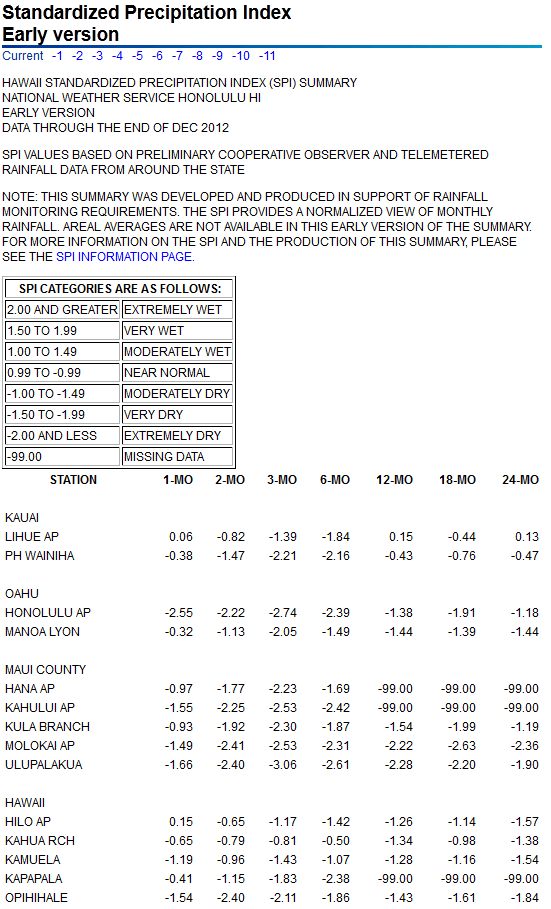
On other Pacific Islands (maps — Micronesia, Marshall Islands, basinwide), December was drier than normal for Guam, Lukonor, Majuro, Pohnpei, and Saipan. December rainfall amounts were below four inches at Guam and Saipan and below 8 inches at Lukonor and Majuro. The reservoir on Majuro was at 50 percent capacity. Majuro has been below normal for 8 of the last 9 months. Total rainfall for the year (January-December 2012) was above normal for all stations except Koror, Majuro, and Pohnpei.
| Station Name | Jan 2012 | Feb 2012 | Mar 2012 | Apr 2012 | May 2012 | Jun 2012 | Jul 2012 | Aug 2012 | Sep 2012 | Oct 2012 | Nov 2012 | Dec 2012 | Jan- Dec |
|---|---|---|---|---|---|---|---|---|---|---|---|---|---|
| Chuuk | 57% | 181% | 107% | 40% | 173% | 131% | 141% | 169% | 86% | 128% | 144% | 116% | 117% |
| Guam NAS | 162% | 94% | 215% | 121% | 224% | 107% | 66% | 179% | 126% | 92% | 74% | 55% | 100% |
| Kapingamarangi | 109% | 71% | 121% | 102% | 143% | 179% | 146% | 192% | 147% | 138% | 167% | 74% | 117% |
| Koror | 36% | 126% | 121% | 120% | 122% | 95% | 88% | 102% | 111% | 78% | 67% | 103% | 88% |
| Kosrae | 65% | 185% | 60% | 84% | 86% | 99% | 124% | 144% | 109% | 113% | 119% | 110% | 89% |
| Kwajalein | 134% | 114% | 84% | 68% | 161% | 117% | 120% | 95% | 57% | 73% | 45% | 230% | 97% |
| Lukonor | 86% | 124% | 135% | 76% | 106% | 125% | 82% | 73% | 148% | 74% | 178% | 62% | 90% |
| Majuro | 107% | 65% | 194% | 97% | 59% | 81% | 68% | 87% | 67% | 46% | 154% | 53% | 86% |
| Pago Pago | 61% | 98% | 131% | 90% | 126% | 115% | 105% | 59% | 195% | 54% | 181% | 143% | 99% |
| Pohnpei | 82% | 138% | 98% | 45% | 115% | 100% | 92% | 96% | 90% | 82% | 109% | 71% | 89% |
| Saipan | 77% | 183% | 35% | 33% | 166% | 118% | 77% | 135% | 101% | 172% | 31% | 89% | 106% |
| Yap | 33% | 117% | 185% | 89% | 142% | 99% | 84% | 128% | 187% | 140% | 121% | 102% | 115% |
| Station Name | Jan 2012 | Feb 2012 | Mar 2012 | Apr 2012 | May 2012 | Jun 2012 | Jul 2012 | Aug 2012 | Sep 2012 | Oct 2012 | Nov 2012 | Dec 2012 | Jan- Dec |
|---|---|---|---|---|---|---|---|---|---|---|---|---|---|
| Chuuk | 5.74" | 13.13" | 8.87" | 5.02" | 19.56" | 15.27" | 16.92" | 21.78" | 10.04" | 14.68" | 15.30" | 13.09" | 159.4" |
| Guam NAS | 6.50" | 2.85" | 4.45" | 3.05" | 7.63" | 6.63" | 6.74" | 26.42" | 15.98" | 10.56" | 5.45" | 2.81" | 99.07" |
| Kapingamarangi | 9.94" | 6.61" | 13.82" | 13.91" | 17.24" | 24.68" | 20.65" | 15.57" | 14.56" | 11.32" | 15.44" | 7.25" | 170.99" |
| Koror | 3.65" | 10.81" | 9.03" | 8.79" | 14.49" | 16.54" | 16.36" | 13.72" | 13.01" | 9.23" | 7.68" | 11.52" | 134.83" |
| Kosrae | 10.89" | 23.93" | 9.59" | 14.70" | 15.35" | 14.56" | 18.55" | 20.46" | 15.52" | 12.33" | 16.49" | 17.75" | 190.12" |
| Kwajalein | 4.22" | 3.01" | 1.97" | 3.58" | 10.82" | 8.08" | 11.83" | 9.23" | 6.17" | 8.18" | 5.09" | 15.33" | 87.51" |
| Lukonor | 7.22" | 11.06" | 12.51" | 8.60" | 12.35" | 14.53" | 13.08" | 10.26" | 15.02" | 8.39" | 16.18" | 7.00" | 136.2" |
| Majuro | 8.27" | 4.46" | 12.75" | 9.14" | 5.96" | 8.89" | 7.54" | 10.15" | 7.47" | 5.84" | 20.69" | 6.09" | 107.25" |
| Pago Pago | 8.14" | 11.76" | 14.00" | 8.41" | 12.15" | 6.13" | 5.84" | 3.19" | 12.73" | 4.99" | 18.34" | 18.31" | 123.99" |
| Pohnpei | 10.75" | 13.17" | 12.92" | 8.31" | 22.98" | 14.86" | 14.21" | 13.62" | 11.27" | 12.59" | 16.18" | 11.37" | 162.23" |
| Saipan | 1.96" | 4.75" | 0.66" | 0.88" | 3.96" | 4.26" | 6.86" | 17.73" | 10.24" | 18.31" | 1.75" | 3.44" | 74.8" |
| Yap | 2.11" | 6.09" | 8.43" | 5.00" | 11.14" | 11.95" | 12.74" | 18.92" | 25.19" | 17.08" | 10.67" | 8.68" | 138" |
| Station Name | Jan 2012 | Feb 2012 | Mar 2012 | Apr 2012 | May 2012 | Jun 2012 | Jul 2012 | Aug 2012 | Sep 2012 | Oct 2012 | Nov 2012 | Dec 2012 | Jan- Dec |
|---|---|---|---|---|---|---|---|---|---|---|---|---|---|
| Chuuk | 10.10" | 7.25" | 8.32" | 12.47" | 11.30" | 11.66" | 11.98" | 12.86" | 11.71" | 11.51" | 10.61" | 11.25" | 136.77" |
| Guam NAS | 4.01" | 3.03" | 2.07" | 2.53" | 3.40" | 6.18" | 10.14" | 14.74" | 12.66" | 11.44" | 7.38" | 5.11" | 99.09" |
| Kapingamarangi | 9.15" | 9.27" | 11.43" | 13.64" | 12.08" | 13.78" | 14.15" | 8.13" | 9.93" | 8.19" | 9.27" | 9.84" | 145.85" |
| Koror | 10.18" | 8.56" | 7.44" | 7.32" | 11.83" | 17.48" | 18.53" | 13.50" | 11.77" | 11.84" | 11.39" | 11.16" | 152.90" |
| Kosrae | 16.67" | 12.93" | 16.06" | 17.51" | 17.75" | 14.64" | 14.91" | 14.22" | 14.22" | 10.94" | 13.83" | 16.11" | 213.87" |
| Kwajalein | 3.16" | 2.64" | 2.35" | 5.26" | 6.72" | 6.93" | 9.87" | 9.74" | 10.74" | 11.18" | 11.28" | 6.66" | 90.41" |
| Lukonor | 8.41" | 8.93" | 9.26" | 11.31" | 11.69" | 11.65" | 15.93" | 14.04" | 10.15" | 11.32" | 9.08" | 11.27" | 151.36" |
| Majuro | 7.74" | 6.88" | 6.58" | 9.42" | 10.11" | 11.01" | 11.17" | 11.69" | 11.17" | 12.73" | 13.44" | 11.39" | 125.25" |
| Pago Pago | 13.34" | 12.00" | 10.68" | 9.39" | 9.66" | 5.33" | 5.55" | 5.38" | 6.53" | 9.26" | 10.14" | 12.84" | 125.57" |
| Pohnpei | 13.18" | 9.55" | 13.17" | 18.41" | 19.96" | 14.81" | 15.43" | 14.26" | 12.55" | 15.27" | 14.83" | 16.08" | 182.36" |
| Saipan | 2.53" | 2.59" | 1.89" | 2.63" | 2.38" | 3.62" | 8.91" | 13.13" | 10.09" | 10.62" | 5.61" | 3.85" | 70.25" |
| Yap | 6.39" | 5.19" | 4.56" | 5.63" | 7.85" | 12.04" | 15.08" | 14.82" | 13.50" | 12.18" | 8.83" | 8.51" | 120.31" |
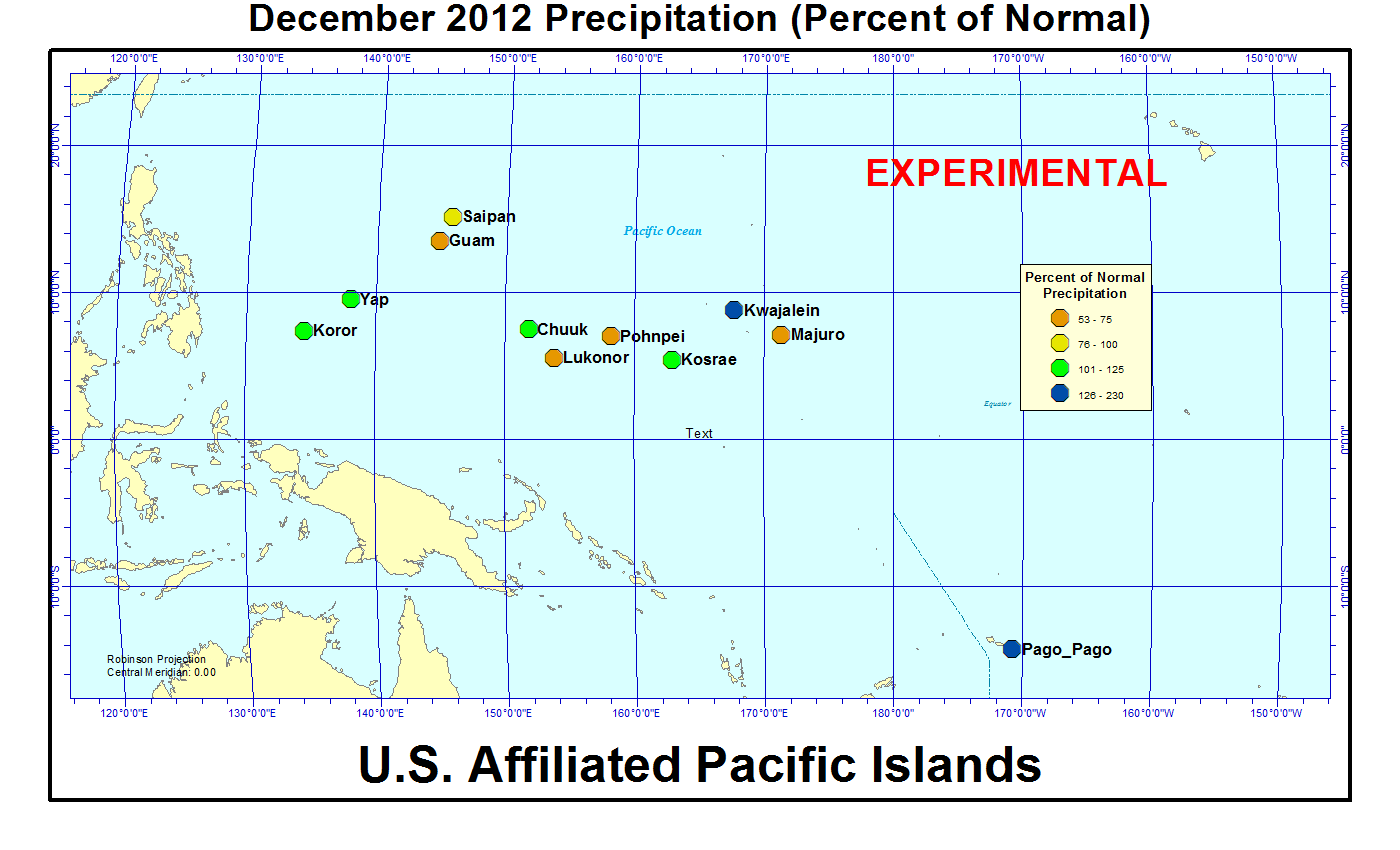

[top]
State/Regional/National Moisture Status
A detailed review of drought and moisture conditions is available for all contiguous U.S. states, the nine standard regions, and the nation (contiguous U.S.):
| northeast u. s. | east north central u. s. | central u. s. |
| southeast u. s. | west north central u. s. | south u. s. |
| southwest u. s. | northwest u. s. | west u. s. |
| Contiguous United States |
[top]
Drought Indicators
- Palmer Drought Indices
- Standardized Precipitation Index
- long-term (36 to 60 month) percent of normal precipitation maps
- airport station percent of normal precipitation maps
- statewide precipitation rank maps
- Cooperative station percent of normal precipitation maps
- percent of average maps for the SNOTEL stations in the western mountains provided by the Western Regional Climate Center
- hydrologic year precipitation
- snow water equivalent of snowpack
- satellite-based observations of vegetative health
- National Weather Service model calculations of soil moisture, runoff, and evaporation
- National Weather Service model calculations of soil moisture using the Leaky Bucket Model
- Midwest Regional Climate Center model calculations of soil moisture
- topsoil moisture conditions observed by the USDA and mapped by the Climate Prediction Center
- pasture and range land conditions observed by the USDA and mapped by the Climate Prediction Center
- streamflow maps maintained by the USGS
[top]
Contacts & Questions
 NOAA's National Centers for Environmental Information
NOAA's National Centers for Environmental Information



